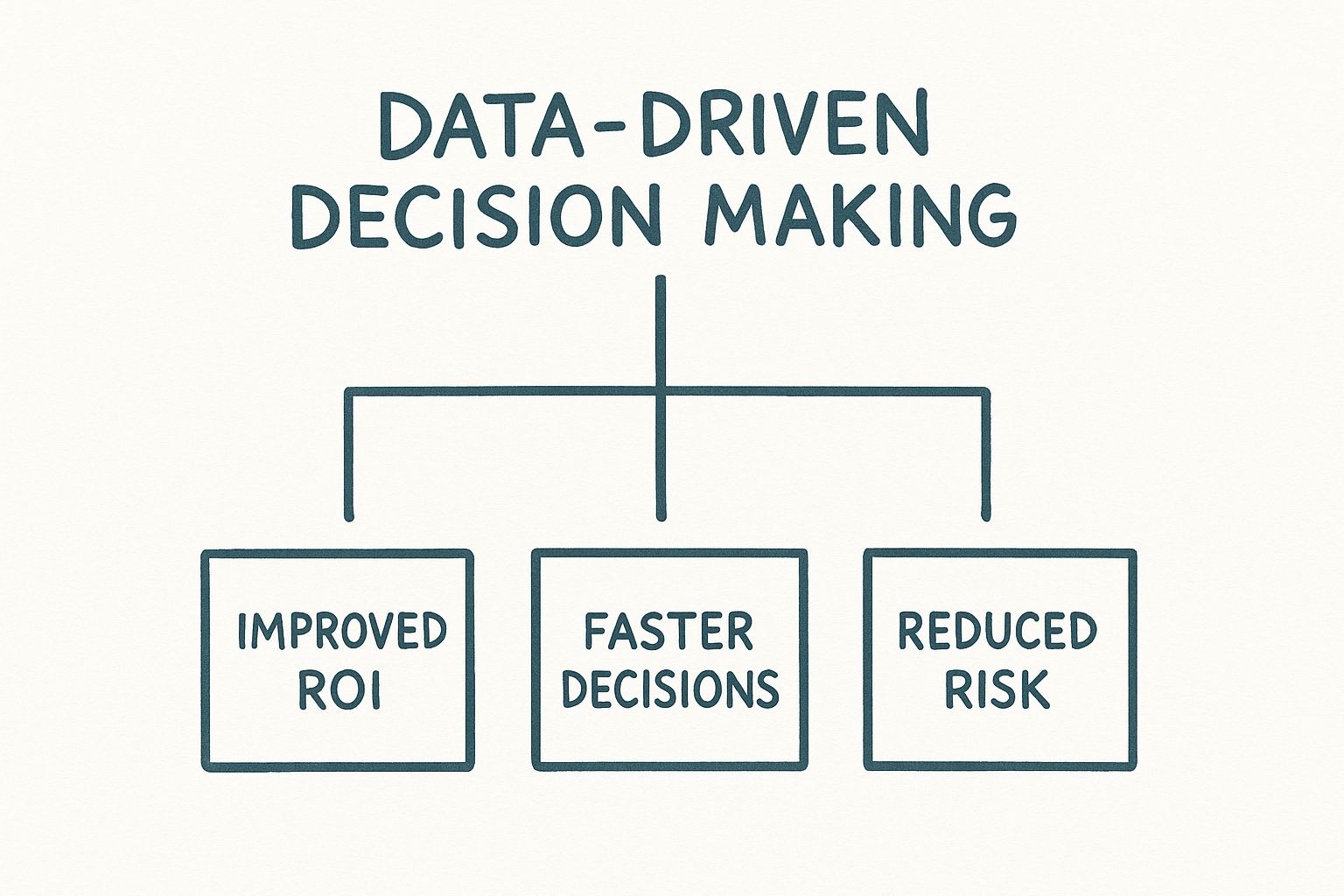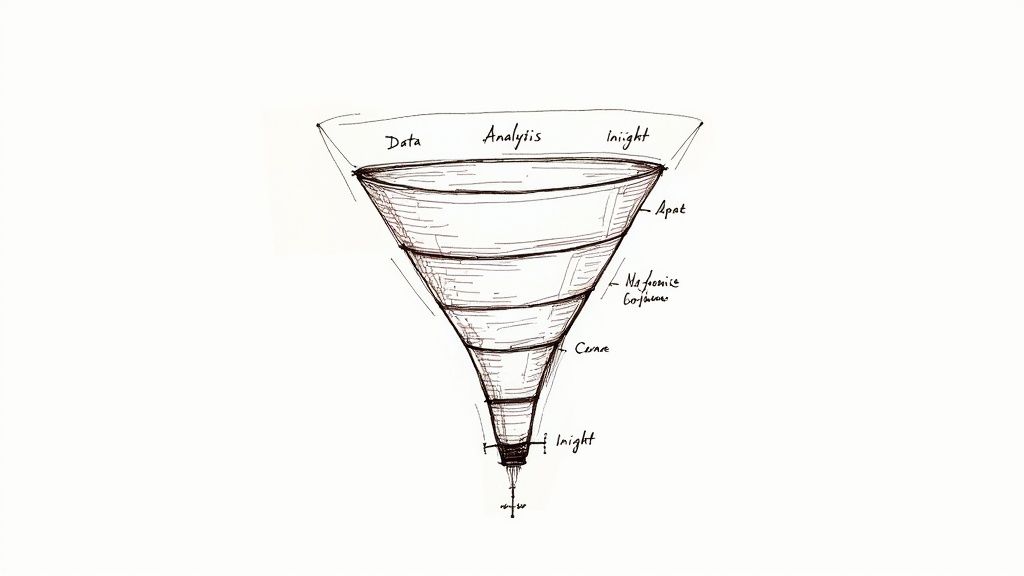October 7, 2025
What is Data Driven Decision Making? Strategies for Success

Data-driven decision-making isn't just a buzzword; it's a fundamental shift in how we approach problems. At its core, it's the practice of making strategic choices based on actual, verifiable data rather than relying solely on intuition or what's worked in the past. It's about swapping guesswork for insights.
What Is Data-Driven Decision Making Anyway?
Think about an old-school sea captain navigating with just the stars and a gut feeling. They might get to their destination, sure, but they're also sailing blind into potential storms. Now, picture a modern captain using GPS, sonar, and detailed weather forecasts. That’s the difference data makes.
Data-driven decision-making is about using the best tools you have to see the whole picture, minimize risk, and chart a clear path forward.
Instead of just going with what feels right, this approach requires evidence. It turns raw numbers into a strategic roadmap, shining a light on hidden opportunities and flagging potential problems before they escalate. This move from intuition to information isn't a luxury anymore; it's essential for any business that wants to grow. In fact, data is now the standard, with 73.5% of managers at leading companies reporting their decisions are always guided by data. You can explore more about this trend in recent industry studies.

Intuitive vs. Data-Driven Decisions At a Glance
Putting these two approaches side-by-side really highlights the contrast. One is rooted in personal experience and feeling, while the other is built on objective facts and measurable results.
Here’s a quick breakdown of how they stack up.
Ultimately, while intuition has its place, a data-driven framework provides a more reliable and defensible way to steer your organization toward its goals.
The Building Blocks of a Data-Driven Strategy
A strong data strategy isn’t something you can just switch on. It's built piece by piece, turning raw information into a real competitive edge. Think of it like a chef creating a masterpiece; it all starts with the right ingredients and a proven process. This process really comes down to three core pillars that work together to bring data-driven decisions to life.
The first step is simply Data Collection. This is all about gathering your raw materials. You're pulling in relevant information from all over the place—customer surveys, website traffic, social media comments, you name it. The key here is to make sure the data is clean, accurate, and directly tied to the questions you're trying to answer.
Turning Data Into Actionable Insights
Once you have your ingredients, it's time for Data Analysis. This is where the magic really starts. You begin to sift through, clean, and organize all that information to spot patterns, trends, and connections that weren't obvious before. It’s about taking a jumble of numbers and turning it into something that actually makes sense.
From there, you get to the most important step: Insight Generation. This is where you figure out what the data is really telling you. If the analysis shows you what happened (e.g., "sales dropped last quarter"), the insight tells you why it happened and what to do about it (e.g., "competitor X ran a major campaign, so we need to counter with a targeted promotion").
This flowchart shows how these steps flow together to produce real business results.

As you can see, committing to this cycle is what leads to tangible benefits like minimizing risk and boosting your bottom line.
A crucial building block for any sophisticated data-driven strategy is the implementation of predictive analytics, which transforms historical data into future insights. This advanced analysis helps organizations move from reacting to the past to proactively shaping the future.
For any modern company, these building blocks are non-negotiable. For example, many are now using a talent intelligence platform to bring this same data-first approach to their hiring process, helping them find better candidates faster and with far less guesswork.
Why Smart Businesses Prioritize Data-Driven Decisions

Moving from gut feelings to data-backed facts isn't just a popular trend—it's a core strategy that directly fuels the bottom line. When businesses build their decisions on data, they stop playing defense and start creating a real competitive edge. They turn raw information into tangible wins, like higher profits and customers who stick around for the long haul.
Relying on guesswork is one of the most expensive mistakes you can make today. When you dig into your operational data, you start spotting all the hidden inefficiencies that quietly drain your budget. In the same way, understanding customer behavior data helps you build retention campaigns that actually work, keeping your best clients happy and engaged.
The Proven Return on Investment
The proof is in the numbers. Companies that truly weave data into their daily operations see incredible results. This isn't about having a siloed analytics team; it's about making data part of everyone's job, from the C-suite to the front lines.
Research paints a clear picture: organizations that are deeply committed to this approach are 6 times more likely to retain customers. Even more impressive, they are a staggering 19 times more likely to be profitable than their less data-savvy competitors.
This undeniable link between data and success is why smart leaders are looking past simple, surface-level metrics. They know that using data driven marketing insights is crucial for driving growth and staying relevant. By making informed choices, they consistently achieve:
- Increased Efficiency: They can pinpoint and eliminate process bottlenecks that slow everyone down.
- Enhanced Customer Satisfaction: They create personalized experiences based on what customers actually do, not just what they say they'll do.
- Greater Profitability: They optimize everything from pricing and marketing spend to new product launches.
So, what is data-driven decision-making at its core? It's the engine that powers sustainable growth. It turns abstract numbers into a clear, actionable roadmap for success, transforming uncertainty into a measurable advantage that helps you navigate challenges and seize opportunities with genuine confidence.
How to Build a Data-Driven Culture in Your Business
Making the switch to a data-driven approach is less about buying new software and more about building new habits. It's a fundamental cultural shift, weaving data into the very DNA of how your company operates. Here’s a practical, five-step roadmap to make data-driven decisions a real, sustainable part of your business.
1. Start with Your Business Goals
Before you even glance at a spreadsheet, you need to know what you’re trying to accomplish. You don't collect data just for the sake of it; you use it to answer your most pressing business questions. A great place to start is by asking, "What critical problem are we trying to solve right now?"
Maybe you need to boost customer retention, slash operational costs, or make your hiring process more efficient. Having clear goals gives you direction and ensures your data efforts are laser-focused on things that deliver tangible, measurable value from the get-go.
2. Pinpoint Your Key Data Sources
Once you know what you’re aiming for, you can figure out where the answers are hiding. The good news is your business is already sitting on a goldmine of information.
- Customer Data: Think about your CRM, website analytics, and customer feedback surveys. It’s all there.
- Operational Data: Look inside your project management tools, supply chain software, and internal performance reports.
- Financial Data: Your accounting system is packed with crucial details on revenue, expenses, and overall profitability.
The trick is to connect these sources back to your business goals. You're essentially drawing a map from the information you have to the insights you desperately need.
3. Select the Right Tools for the Job
With your goals set and your data sources mapped out, it’s time to pick your gear. The market is flooded with tools, from the straightforward dashboards in Google Analytics to powerful business intelligence platforms. Don't let the options overwhelm you. The best tool is simply the one your team will actually use.
Look for solutions that are user-friendly and don't require a Ph.D. in data science to operate. This is key to breaking down information silos and getting everyone, not just the analysts, comfortable with looking at the numbers.
4. Empower Your Team with Data Literacy
A data-driven culture can't exist without curiosity and skill. Data literacy—the ability to read, question, and talk about data—isn't just for specialists anymore. It's a core competency for everyone. You have to invest in training that teaches your team how to ask smarter questions and interpret the answers with confidence.
This kind of cultural upgrade is a huge part of the bigger push for efficiency, much like the changes happening with digital transformation in HR, where new skills and tools are helping teams work smarter.
Fostering a data-literate environment means encouraging people to challenge assumptions with evidence. It's about celebrating insights, especially when they prove a long-held belief wrong.
5. Test, Learn, and Repeat
Finally, remember that this isn't a one-and-done project. It’s a continuous loop. You start with a hypothesis, use data to test it, and then learn from what happens. It doesn't matter if your test is a roaring success or a complete flop—either way, you walk away with valuable knowledge that sharpens your next move.
This cycle of testing, learning, and repeating is what builds momentum. It creates a powerful feedback loop that constantly refines your strategies, making your organization smarter and more agile over time.
The Future of Decision Making with AI and Automation

The next major leap in data-driven decision-making is already here, and it’s happening at the intersection of artificial intelligence and automation. These technologies aren't about replacing human instinct; they're about amplifying it. They give businesses the power to stop just reacting to what’s already happened and start proactively shaping what comes next.
Think about an e-commerce site that seems to know what you want before you even search for it. Or a factory floor where AI predicts a machine failure and schedules maintenance before a costly breakdown ever occurs. That’s the core of modern data-driven decision-making—it’s like having a crystal ball built on code.
AI achieves this by sifting through enormous datasets to find subtle patterns that would be completely invisible to a human team. It automates incredibly complex analysis, turning raw information into a roadmap for the future.
The Rise of Predictive Insights
By 2025, artificial intelligence is expected to be a standard part of decision-making in most major industries. This isn't some far-off concept; the shift is well underway. In fact, nearly 65% of organizations are already using or actively exploring AI for their analytics. We've come a long way from relying on simple spreadsheets.
This evolution is making a huge impact in fields like talent acquisition. Companies can now use AI to comb through candidate data and predict future job performance with surprising accuracy. This frees up hiring managers to pour their time and energy into the people who are most likely to succeed, right from the very start.
The real magic of AI in decision-making is its ability to transform historical data into forward-looking intelligence. It doesn't just answer "what happened?" but "what's likely to happen next, and what should we do about it?"
This forward-looking approach is changing everything from marketing and operations to finance and HR. To see a concrete example, take a look at how to use AI in recruiting and discover how it helps build smarter, more effective hiring strategies.
Of course. Here is the rewritten section, focusing on a more natural, human-expert tone while keeping all the original information and formatting.
Your Top Questions About Data-Driven Decision Making, Answered
Making the switch to a data-driven approach is a big move, and it's natural to have questions. In my experience, most teams run into the same practical hurdles and concerns. Let’s tackle a few of the most common ones head-on.
Do I Need to Be a Data Scientist to Do This?
Not at all. This is probably the biggest misconception out there. While data scientists are invaluable for deep, complex analysis, the whole point of modern data-driven decision making is to get information into the hands of everyone who needs it.
The goal isn't to turn your entire team into statisticians. It's about building data literacy—the skill of asking smart questions, understanding what the data is telling you, and using that story to make a better call. Modern analytics tools are built with user-friendly dashboards for this exact reason. Think of it less like doing complicated math and more like learning to read a much better map.
What Are the Biggest Roadblocks I’ll Face?
Interestingly enough, the toughest challenges are rarely about the technology. They're almost always about people. When businesses struggle to build a data-driven culture, it usually comes down to one of these three things:
- Resistance to Change: People are used to trusting their gut. It can be a real adjustment to start trusting the numbers, especially when they contradict long-held beliefs.
- Lack of Leadership Buy-In: If senior leaders aren't championing the shift, it's dead in the water. Their consistent support is non-negotiable.
- Data Silos: It’s impossible to see the full picture when your data is trapped in separate departments and disconnected systems.
Getting past these hurdles requires strong leadership, being upfront about why you're making this change, and giving teams the right training and tools to make data easy to work with.
I Run a Small Business. How Can I Even Get Started?
Start small. Seriously. The key is to aim for a quick, meaningful win instead of trying to boil the ocean. Don't set out to analyze your entire business at once.
Pick one specific, high-impact question you need an answer to. For example, you could ask, "Which marketing channel brings us our most profitable customers?" or "What was our hottest product during last year's holiday rush?"
You probably have the data you need already in tools like Google Analytics or your payment system. When you find a clear, actionable answer, you not only improve the business but also build momentum. That first win is crucial for showing everyone on the team what's possible.
Ready to make smarter, faster hiring decisions? Klearskill uses AI to analyze candidate data, eliminating bias and identifying top talent with 95% accuracy. Discover how you can reduce screening time by 92% today.
